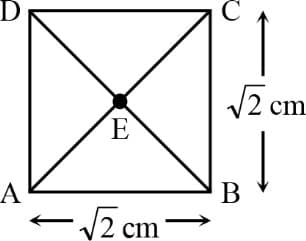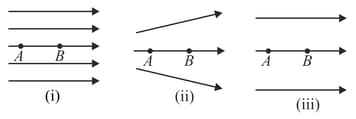The given square is drawn in a uniform electric field. The potential at the corners , , , and is , , and , respectively. At centre , the potential is , then the magnitude of the electric field is

Important Questions on Electrostatics

Figure shows three arrangements of electric field lines. In each arrangement, a proton is released from rest at point A and then accelerated through point B by the electric field. Points A and B have equal separations in the three arrangements. If and are linear momentum of the proton at point B in the three arrangement respectively, then

(i) A negative test charge experiences a force opposite to the direction of the field.
(ii) The tangent drawn to a line of force represents the direction of electric field.
(iii) The electric field lines never intersect.
(iv) The electric field lines form a closed loop.
What is the direction of electric field with respect to an equipotential surface?
The electric field lines of a positive charge is as shown in figure. What is the shape of equipotential surface near the charge ?

(figures are schematic and not drawn to scale)
A small point mass carrying some positive charge on it, is released from the edge of a table. There is a uniform electric field in this region in the horizontal direction. Which of the following options then correctly describe the trajectory of the mass ? (Curves are drawn schematically and are not to scale)
Define:
Equipotential surface.
Draw equipotential surface due to an isolated point charge and depict the electric field lines.
The equipotential surface through a point is normal to the electric field at that point.
What is the work done to move a charge on an equipotential surface?
The equipotential surface through a point is normal to the electric field at that point.
What is meant by equipotential surface?
The electric field lines on the left have twice the separation on those on the right as shown in figure. If the magnitude of the field at is , what is the force on charge kept at


